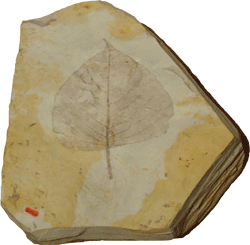Plants
The major portion of these plant collections from the later Paleozoic and Tertiary is in the form of leaf and stem impressions and carbon remnants. Also represented are three dimensional colorful silicified pieces of ‘wood’, ‘petrified wood’. The parens included here because not all this plant material is strictly fossilized wood tissue derived from the cambium. Huge palm roots from the Tertiary Gulf coastal plain, and intriguing bored wood from the Cretaceous are also included in the collections.
Oscar M. Ball Collection
Oscar Ball was a paleobotanist at Texas A&M between 1905-1937. He was head of the Biology Department from 1916-1937. The Oscar Ball paleobotanical collection was moved from Texas A&M to Houston Museum of Science and thence to the Texas Memorial Museum in 1979. Further specimens were brought from TAMU in 2003. It is an important collection largely composed of Eocene plant material. O.M. Ball worked on these specimens during the 1930’s. The collection contains a detailed card index providing taxonomic and provenance data. The collection comprises over 800 specimens.
View the O.M. Ball Collection catalog.
WPA State Survey Collection
The Works Progress Administration projects between 1936-1943 generated a wealth of geological specimens from well-organized expeditions. This plant collection is primarily of Paleozoic age from Texas localities.
T.F. Steussy and R.S. Irving Collection
Stuessy and Irving were graduate students at the University of Texas at Austin. They deposited a small but interesting collection of fossil leaves.
Stuessy, T. F. & R. S. Irving. 1968. A morphological fossil plant species, Euonymus glanduliferus. Southwestern Naturalist, vol. 13 (3): 353-357, 2 fig. (hypotypes)
Other Fossil Plants
Paleozoic: One of the earliest female paleontologists, Hedwig Kniker, left several beautiful specimens from the classic Mazon Creek site in Illinois.
Mesozoic: Interesting Cretaceous silicified (‘petrified’) specimen bored by marine bivalves.
Cenozoic: Beautiful leaves from the Gulf region Tertiary deposits. In addition to large palm roots.


